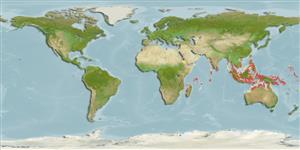>
Siluriformes (Catfishes) >
Ariidae (Sea catfishes) > Ariinae
Etymology: Arius: Greek, arios, areios = dealing with Mars, warlike, bellicose (Ref. 45335).
More on author: Valenciennes.
Environment: milieu / climate zone / depth range / distribution range
Écologie
marin; saumâtre démersal; non migrateur; profondeur 0 - 20 m (Ref. 43081). Tropical
Indo-West Pacific: Pakistan east to Thailand then south to the Philippines and Indonesia.
Taille / Poids / Âge
Maturity: Lm ? range ? - ? cm
Max length : 39.5 cm NG mâle / non sexé; (Ref. 43081); common length : 12.0 cm TL mâle / non sexé; (Ref. 3290)
Found in marine waters, as well as estuaries and tidal rivers, at times burrowed in the soft mud of the mangroves. Feed mainly on invertebrates. Males incubate the eggs in the buccal cavity (Ref. 43081). The sharp dorsal and pectoral fin spines can inflict painful wounds. Also caught with dipnets and set bagnets. Sold mostly fresh.
Males incubate the eggs in the buccal cavity.
Jayaram, K.C., 1984. Ariidae. In W. Fischer and G. Bianchi (eds.) FAO species identification sheets for fishery purposes. Western Indian Ocean fishing area 51. Vol. 1. FAO, Rome. pag. var. (Ref. 3290)
Statut dans la liste rouge de l'IUCN (Ref. 130435)
Menace pour l'homme
Traumatogenic (Ref. 3290)
Utilisations par l'homme
Pêcheries: commercial
Plus d'informations
RéférencesAquacultureProfil d'aquacultureSouchesGénétiqueElectrophoresesHéritabilitéPathologiesTraitementNutrientsMass conversion
CollaborateursImagesStamps, Coins Misc.SonsCiguateraVitesseType de nageSurface branchialeOtolithesCerveauxVision
Outils
Articles particuliers
Télécharger en XML
Sources Internet
Estimates based on models
Preferred temperature (Ref.
123201): 27.4 - 29.3, mean 28.7 °C (based on 1689 cells).
Phylogenetic diversity index (Ref.
82804): PD
50 = 0.5000 [Uniqueness, from 0.5 = low to 2.0 = high].
Bayesian length-weight: a=0.00776 (0.00492 - 0.01225), b=2.98 (2.85 - 3.11), in cm total length, based on LWR estimates for this species & (Sub)family-body (Ref.
93245).
Niveau trophique (Ref.
69278): 2.8 ±0.31 se; based on food items.
Résilience (Ref.
120179): Faible, temps minimum de doublement de population : 4,5 à 14 années (Fec=25-35).
Fishing Vulnerability (Ref.
59153): Moderate vulnerability (35 of 100).
